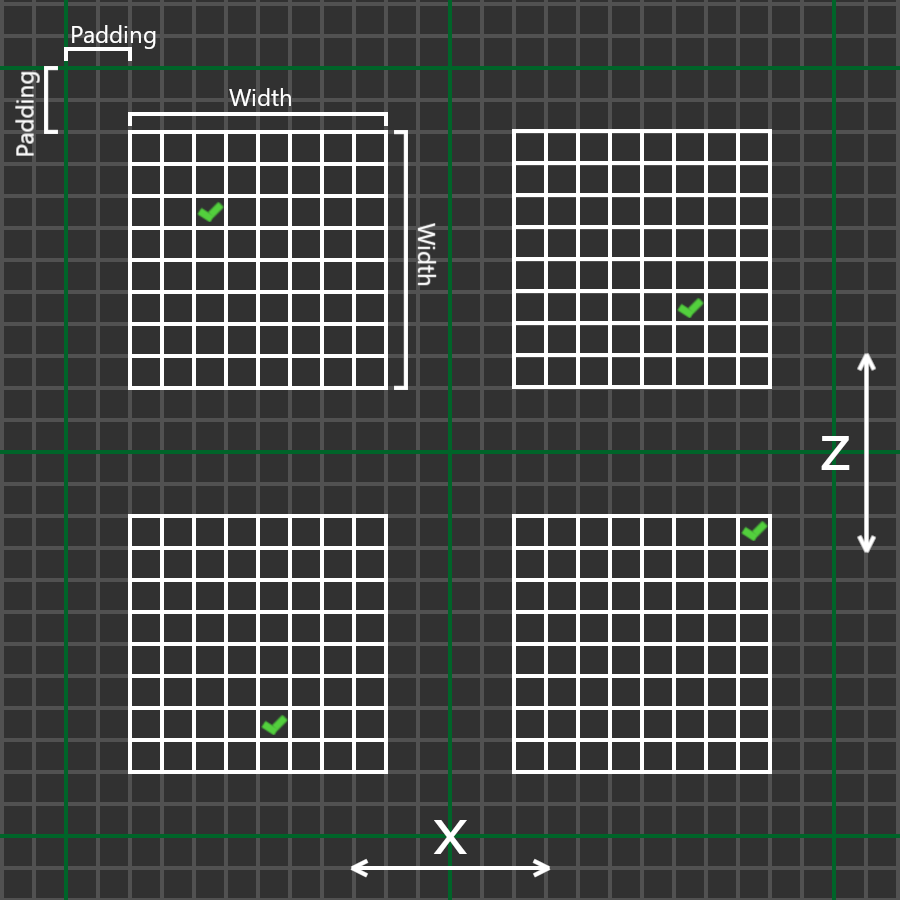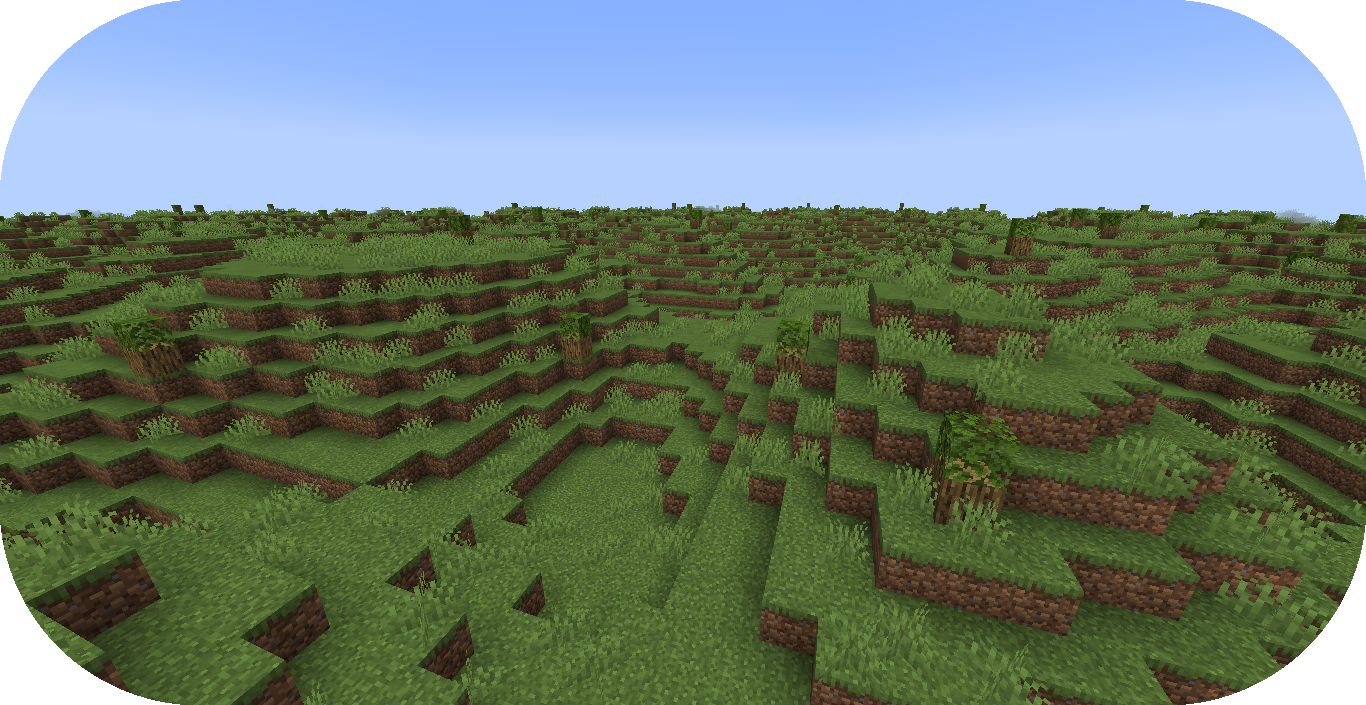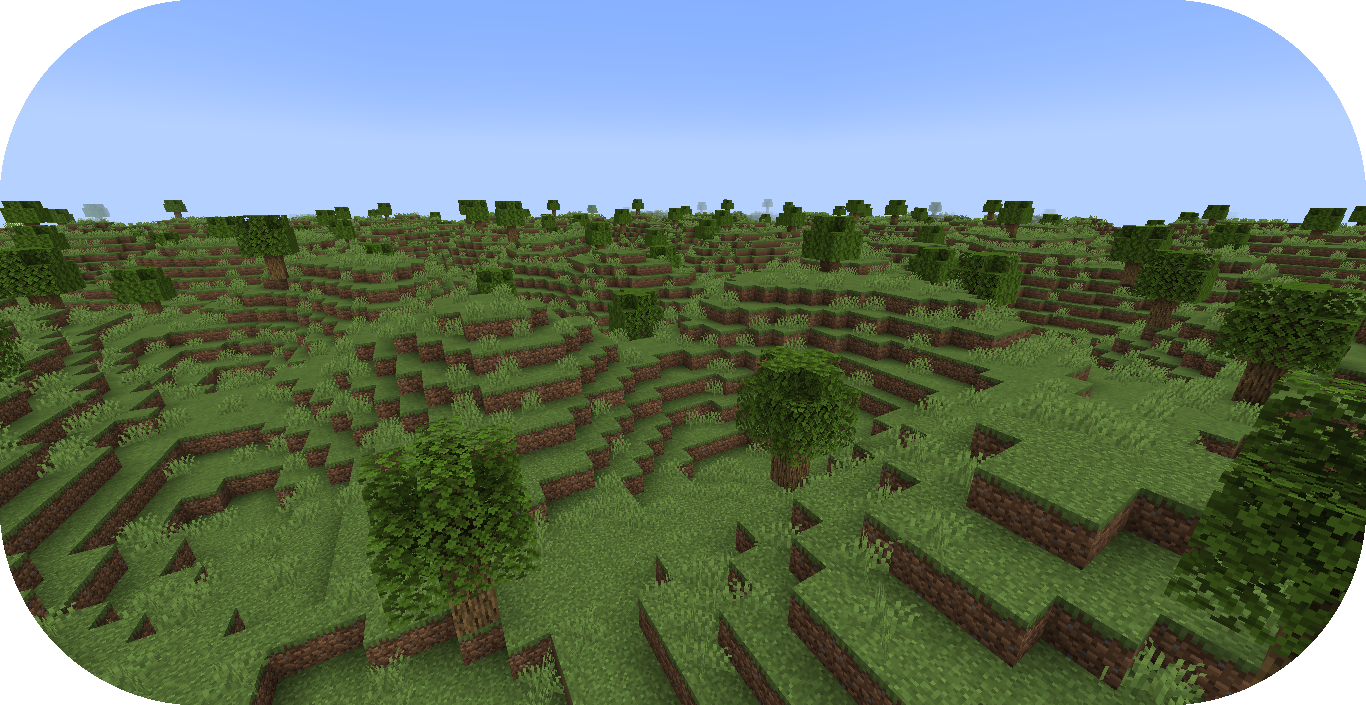Creating a Feature with a Structure From Scratch¶
This guide will outline the process of creating a new feature from the beginning with adding tree structures.
If you haven’t already, please read the Config Development Introduction & Creating A Pack From Scratch for more information before continuing.
For a more detailed and in-depth guide about creating a new feature from scratch, please read this unofficial development guide, Feature Config.
If you’re stuck or need an example, you can find reference config packs for this guide on the GitHub repo.
Setting up a New Structure¶
PROCEDURE
1. Create your structure file¶
Structure files can
either be dynamic TerraScript .tesf or static schematic .schem files.
TerraScript files are written in the TerraScript Language. TerraScript allows for procedurally generated structures and unique complex structure layouts.
Add the
structure-terrascript-loaderaddon to the pack manifest, using versions1.+
1id: YOUR_PACK_ID
2version: 0.5.0
3
4addons:
5 ...
6 structure-terrascript-loader: "1.+"
Create a blank
.tesffile.Add TerraScript within the
.tesffile to generate the structure.
oak_tree.tesf will be the example file name used for this guide.
A barebones sample oak_tree.tesf file has been provided below if you need it.
1block(0, 0, 0, "minecraft:oak_log", true);
2block(0, 1, 0, "minecraft:oak_leaves", false);
Schematic files consist of an arrangement of blocks that make up a structure that can be saved through WorldEdit.
Add the
structure-sponge-loaderaddon to the pack manifest, using versions1.+
1id: YOUR_PACK_ID
2version: 0.5.0
3
4addons:
5 ...
6 structure-sponge-loader: "1.+"
Source a
.schemfile, these can be created using WorldEdit if you wish to create your own.Add the
.schemfile to your pack.
oak_tree.schem will be the example file name used for this guide.
A sample oak_tree.schem can be found on GitHub if needed.
Warning
If you decide to try out both structure file types, be sure to name them differently as you can’t have structure files with the same name.
2. Create new generation stage¶
It’s best to categorize feature into different stages to not only keep feature organization tidy, but to allow particular features to generate before others.
For example, you may want to generate trees before grass, so trees aren’t blocked from generating by the grass.
We will now utilize the generation-stage-feature addon that was added in
Setting up a New Feature to
create a new generation stage.
1id: YOUR_PACK_ID
2
3...
4
5stages:
6 - id: trees
7 type: FEATURE
8 # The trees generation stage will come before flora, making it generate first.
9 - id: flora
10 type: FEATURE
Important
The generation stage ids can be named to your liking and generation stages will generate in order from top to bottom.
3. Create your feature config¶
We will now utilize the config-feature addon that was added in
Setting up a New Feature to
create a new feature config file.
Create a blank config file with the file name oak_tree_feature.yml.
Set the config type via the type
parameter, and config id as shown below.
1id: OAK_TREE_FEATURE
2type: FEATURE
4. Add the feature distributor¶
We will now utilize the config-distributors addon that was added in
Setting up a New Feature to add the distributor.
Configure oak_tree_feature.yml to utilize the PADDED_GRID distributor type as shown below.
1id: OAK_TREE_FEATURE
2type: FEATURE
3
4distributor:
5 type: PADDED_GRID
6 width: 12
7 padding: 4
8 salt: 5864
The PADDED_GRID distributor type utilizes cells in a grid with
the feature placed within each cell with padding between each cell
to ensure that features don’t generate too close to one another.
PADDED_GRID utilizes the nested parameters width, padding, and salt.
Width- Determines the size of each cell that will contain your feature.Padding- Determines the gap between each cell.Salt- Typically a random number that offsets the distributor results to prevent feature placement overlap with the same distributor type. Salt function covered in detail here.

Note
Documentation of PADDED_GRID and other distributor types can be found here.
5. Add the feature locator¶
We will now utilize the config-locators addon that was added in
Setting up a New Feature to add the locator.
Configure oak_tree_feature.yml to utilize the TOP locator type as shown below.
1id: OAK_TREE_FEATURE
2type: FEATURE
3
4distributor:
5 ...
6
7locator:
8 type: TOP
9 range:
10 min: 0
11 max: 319
The TOP locator type will place the feature on the block located at the highest y-level rather than every block
with air above it with the SURFACE locator.
Note
Documentation of the various locator types available can be found here.
6. Improve feature locator¶
Just like with the SURFACE locator when adding short grass, the TOP locator is handy for placing features at
the highest block, but it doesn’t check the block it places the feature upon.
Utilizing the AND locator, we can use multiple locators for
stricter criteria for where the feature can generate.
Using the PATTERN locator with the type specified to use MATCH_SET will allow us to specify the blocks
that must match in order to generate the feature.
Add the highlighted lines below to add the additional locator.
1id: OAK_TREE_FEATURE
2type: FEATURE
3
4distributor:
5 ...
6
7locator:
8 type: AND
9 locators:
10 - type: TOP
11 range: &range #range values anchored for other locators to use
12 min: 0
13 max: 319
14 - type: PATTERN
15 range: *range #references previously anchored range values
16 pattern:
17 type: MATCH_SET
18 blocks:
19 - minecraft:grass_block
20 - minecraft:dirt
21 offset: -1
7. Add the structure¶
Tip
Features can select from a weighted list of structures with a noise sampler to guide the structure selection as shown below.
1structures:
2 distribution:
3 type: WHITE_NOISE
4 salt: 4357
5 structures:
6 - oak_tree_1: 1
7 - oak_tree_2: 1
8 - oak_tree_3: 1
Weighted lists covered in detail here.
8. Apply feature to biome¶
We’ll now add the tree feature to FIRST_BIOME.
Add the highlighted lines below to the FIRST_BIOME config.
1id: FIRST_BIOME
2type: BIOME
3
4vanilla: minecraft:plains
5
6...
7
8features:
9 trees:
10 - OAK_TREE_FEATURE
11 flora:
12 - GRASS_FEATURE
The OAK_TREE_FEATURE feature should now generate your oak tree structures in FIRST_BIOME.
9. Load your pack¶
At this stage, your pack should now be capable of generating oak trees! You can load up your pack by starting your
development client / server which contains the pack you have just defined. You can confirm that your pack has loaded
if the pack id (as specified in the pack manifest) appears when using the /packs command, or in your console
when starting the server / client up.
If for whatever reason your pack does not load, an error message will show up in console explaining why the pack has failed to load, please read through any of these errors and try to interpret what you may have done wrong, and follow through the previous steps again carefully.
If you still are unable to load the pack, feel free to contact us with any relevant errors.
Conclusion¶
Once you have verified your pack has loaded correctly, you can now generate a world with oak tree structures using features!
Reference configurations for this guide can be found on GitHub here.

